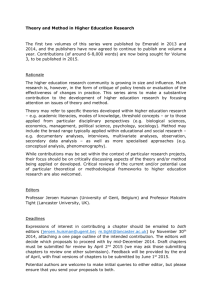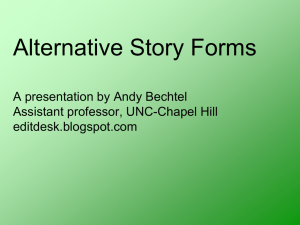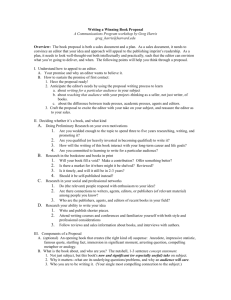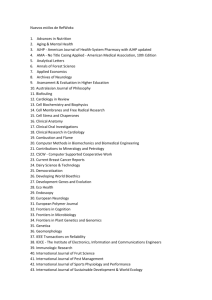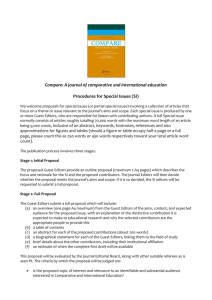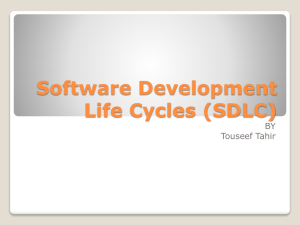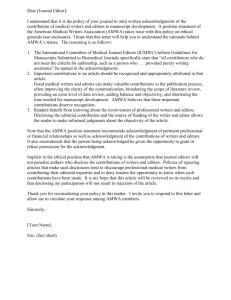Constitution 2014/2015
advertisement
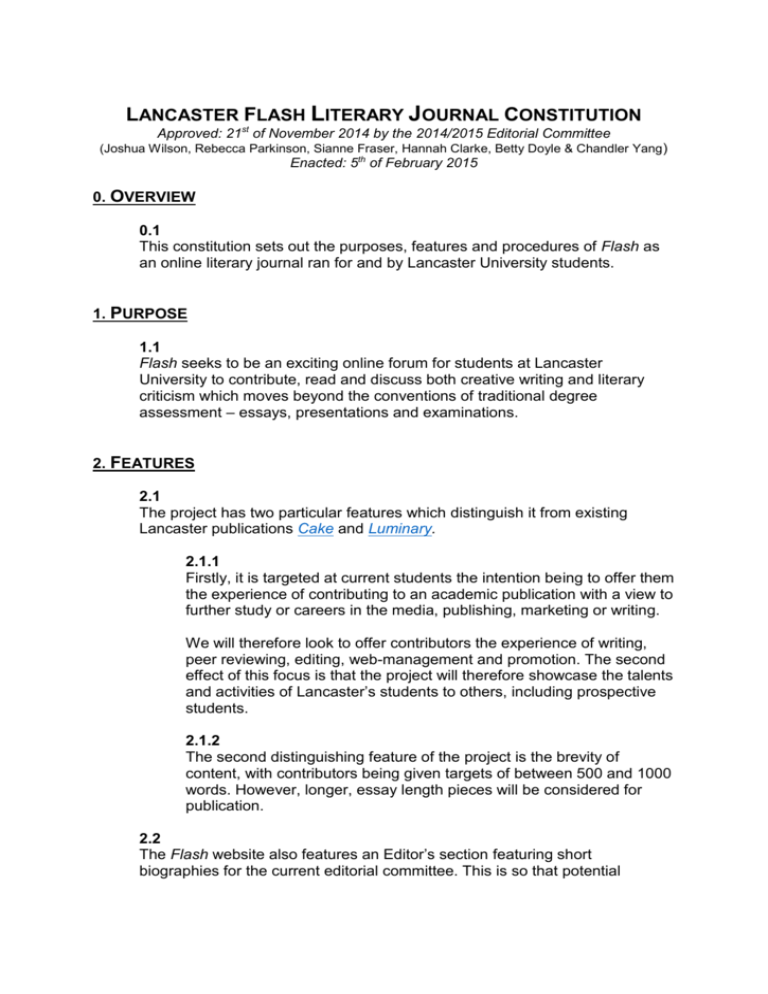
LANCASTER FLASH LITERARY JOURNAL CONSTITUTION Approved: 21st of November 2014 by the 2014/2015 Editorial Committee (Joshua Wilson, Rebecca Parkinson, Sianne Fraser, Hannah Clarke, Betty Doyle & Chandler Yang ) Enacted: 5th of February 2015 0. OVERVIEW 0.1 This constitution sets out the purposes, features and procedures of Flash as an online literary journal ran for and by Lancaster University students. 1. PURPOSE 1.1 Flash seeks to be an exciting online forum for students at Lancaster University to contribute, read and discuss both creative writing and literary criticism which moves beyond the conventions of traditional degree assessment – essays, presentations and examinations. 2. FEATURES 2.1 The project has two particular features which distinguish it from existing Lancaster publications Cake and Luminary. 2.1.1 Firstly, it is targeted at current students the intention being to offer them the experience of contributing to an academic publication with a view to further study or careers in the media, publishing, marketing or writing. We will therefore look to offer contributors the experience of writing, peer reviewing, editing, web-management and promotion. The second effect of this focus is that the project will therefore showcase the talents and activities of Lancaster’s students to others, including prospective students. 2.1.2 The second distinguishing feature of the project is the brevity of content, with contributors being given targets of between 500 and 1000 words. However, longer, essay length pieces will be considered for publication. 2.2 The Flash website also features an Editor’s section featuring short biographies for the current editorial committee. This is so that potential contributors can easily find the interests of our contributors and contact the most appropriate person to discuss their ideas in a peer-review format. 3. CONTRIBUTIONS AND EDITING 3.1 Contributions are welcomed on any subject. 3.2 A dual precedent has been set for submissions between creative and critical pieces, however we are not aiming for prescriptivism; all contributions received will be appraised and edited. 3.3 FEEDBACK GUARANTEE Feedback is guaranteed and the editorial process is regulated by the Executive Editor(s) to ensure a high level of quality. 3.4 REJECTION We reserve the right to reject any pieces for publication with sufficient reason beyond personal subjectivism. 3.4.1 Any rejected pieces must be consulted on by the whole of the editorial committee, though each piece’s assigned editor has the right to reject publication. 3.4.2 We welcome input and advice from academic staff in this process. 4. THE EDITORIAL COMMITTEE STRUCTURE 4.1 MAXIMUM ROLES The Editorial Committee will consist of no more than eight roles to reduce bureaucratic overload. 4.2 ROLES The structure of the Committee is as follows. 4.2.1 There will be no more than six Editors. 4.2.2 There will be no more than two Publicity and Promotion Editors, and no less than one. 4.2.3 There will be no more than two Executive Editors and no less than one. 4.2.4 Individuals may have more than one role, though it is advised that the Committee does not fall below three members. 5. COMMITTEE ROLE DESCRIPTORS 5.1 EDITORS Editors form the body of the Committee. 5.1.1 They are responsible for working with authors who have submitted and providing objective, constructive feedback for the purpose of improving the piece. 5.1.2 All feedback is optional and the author has the right to refuse suggested changes. 5.1.3 Editors may refuse to publish pieces for reasons that must be discussed with the whole Committee. 5.1.4 It is advised to attempt to give feedback to all submissions if possible. 5.2 EXECUTIVE EDITORS Executive Editors are the administrators and nominal heads of the Committee. 5.2.1 Executive Editors ensure the continuation of the Committee, propose changes and votes, organise meetings and manage the Committee. 5.2.2 Executive Editors also serve as first point of contact for the Committee. 5.2.3 ROLE IN TRANSITION Executive Editors appoint the next Committee with review from the Editors. 5.2.4 EDITOR DISMISSAL Executive Editors may dismiss Editors though it is strongly advised to do so only for very good reason, for example if a Committee member is continuously unengaged or if they are bringing purposeful disrepute to the journal. 5.2.5 EDITOR REPLACEMENT Replacement Editors may be appointed by the Executive Editor. 5.3 EXECUTIVE EDITOR DISMISSAL Executive Editors may be removed from the role by a general vote of the Editors. 5.3.1 In the event of a vote of no confidence, a letter explaining why they have been removed should be presented and signed by those who have voted against to VONC them. 5.3.2 A replacement Executive Editor must then be elected. 5.4 PUBLICITY AND EVENTS EDITORS Publicity and Promotion Editors are the face of the journal and work to bring an awareness of Flash by working with relevant faculties, societies and outside organisations. 5.4.1 They function as Editors do with regards to voting, dismissal, transition and so forth. 5.5 RESIGNING At any point during the Committee’s administration, an individual can resign from any position. 5.5.1 The replacement of the individual is at the discretion of the Committee as a whole. 5.5.2 If this leaves the Committee without an Executive Editor, a new one must be elected from amongst the Editors or Publicity Editors. 6. TRANSITION ARRANGEMENTS Transition arrangements here refer to the passing over of the Committee between years. 6.1 Transition arrangements should be made in the summer term and should have sufficient publicity to ensure applications are submitted. 6.2 PRIOR COMMITTEE ROLES IN TRANSITION Transition is managed by the Executive Editors with counsel from the Editors. 6.3 APPLICATION PROCEDURE Candidates should present a manifesto or application, formerly set by the Committee, by a given deadline 6.3.1 The Committee should endeavour to reply within two weeks. 6.4 The successive Committee must be assembled before Michaelmas term (term 1) of the following year. 6.5 PRINCIPLE OF SELECTION Executive Editors should choose those who they believe merit the given position and will further the goals of Flash. 6.6 EDITOR ROLES IN TRANSITION Executive Editors should discuss the candidates with the Editors, but the final decision rests with the Executive Editors. 6.7 METHOD OF TRANSITION A Facebook group should be created for the successive Committee. 6.7.1 Former Executive Editors and the former Publicity Editor can remain a part of this group to oversee the changes the new Committee enacts, or leave as they wish. 6.7.2 Admin privileges should be given to the new Executive Editors. 6.8 HANDOVER DOCUMENTS A handover document should be provided to the new Committee which describes the roles, past traditions, social media account details, and basic WordPress tutorials. 6.8.1 The Committee should prepare this to coincide with the creation of the Facebook group. 6.9 IDEAL EXECUTIVE EDITORS Executive Editor positions should be given to those with the most experience. 6.9.1 We would advise the order for this allocation should give priority to former Committee members, final years, former Flash authors, or those with credible literary or editing experience. 6.10 MULTI-YEAR COMMITTEE MEMBERS In the case that former Committee members wish to remain on the Committee in the successive year, we would advise that these individuals also propose a manifesto equal to new applicants and that past merits are considered. 6.10.1 If former Executive Committee members wish to remain in the role, they must be excluded from deliberating on the positions. 6.10.2 Allocation of this position should be decided by (i) the Executive Editor who is leaving, or (ii) by vote after the Editor and Publicity Editor positions have been filled. 7. VOTING Voting on any matter should be done by simple majority. 7.1 The nature of votes vary on the subject, but we advise secret ballots may be the best way to receive honest responses. 8. AMMENDING THE CONSTITUTION The constitution is the sum and serf of the committee. 8.1 Changes to the constitution may be proposed by any member of the committee 8.2 Changes to the constitution must be voted on and approved by simple majority. 8.2.1 Ties mean that the constitution amendments do not pass, i.e., 51% of votes must be in favour of the proposed change 8.3 Once constitution changes have been approved, they are enacted by uploading the constitution to the Flash website. 8.3.1 Until the constitution is available to the public, it is considered a draft and may not be used to evidence or support decisions. 8.4 We advise reviewing the constitution each year. 8.4.1 If no changes are necessary, vote to continue the current constitution. 8.4.2 This procedure of annual review must be followed in order to keep the constitution recent, represent the current Committee and maintain the integrity of Flash. 8.5 It is up to the Committee whether to submit reviewed constitutions to the Department of English Literature and Creative Writing.
